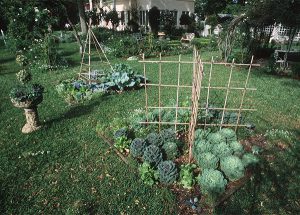- One third of all U.S. households participate in some type of food gardening with vegetable gardening being the most common type.
- UF/IFAS Extension agents from throughout the Sunshine State have released a guide to help consumers design a vegetable garden with cost benefits in mind.
- The guide, Costs and Benefits of Vegetable Gardening, is a free resource that can be downloaded from the UF/IFAS Electronic Data Information Source (EDIS).

FLORIDA. — As April settles us into spring mode, the observance of National Garden Month takes root with greater emphasis for consumers as the Covid-19 pandemic continues.
Scientists and Extension agents at the University of Florida Institute of Food and Agricultural Sciences (UF/IFAS) have published a guide to help consumers plan a vegetable garden with a budget. Available from the UF/IFAS Electronic Data Information Source (EDIS), “Costs and benefits of vegetable gardening” is a free resource designed to meet the public’s demand for information on how to grow produce at home.
“There are lots of good reasons people have vegetable gardens,” said Kevin Athearn, a regional agent with UF/IFAS Extension who serves northeast Florida with programs in agricultural economics and farm business development. “Savings on your food bill can be one reason, but how do you know whether it costs you $1 per pound or $10 per pound to grow tomatoes? This guide will help you estimate your garden vegetable costs and savings.”

While more than one third of U.S. households plant food gardens for a variety of reasons, vegetable gardening is the most popular. Studies show that consumers grow gardens hoping to achieve a variety of perceived benefits. While some consumers plant desired produce as a hobby, others grow food gardens to promote personal wellness, some look to leverage cost savings and reduce supermarket costs, or they hope to enjoy the home-grown experience.
Now that consumers are not as confined to their homes, many are determined to be self-sufficient by transforming their backyards and patios into vegetable gardens as they continue to ride out the COVID-19 pandemic. This has people asking themselves and others: “what do I plant,” and “how do I make the most of my vegetable garden while perhaps saving on my food bill?”
“Our focus is on estimating the costs of materials, including gardening supplies and tools, because growing your vegetable garden for cost savings requires estimating costs,” said Athearn.
The publication provides a workbook of sorts to help consumers determine the cost savings from growing different vegetables. It can also help consumers choose the most economical crops and assess whether a financial benefit is achieved from gardening.
“Due to our deficient soils in South Florida, for example, it is essential to know how to site and prepare a vegetable garden,” said Lorna Bravo, a publication collaborator as well as a horticulture agent and director of UF/IFAS Extension Broward County. “Understanding when and how to plant a garden, as well as manage a garden might make gardening projects fun to harvest year-round.”
To accompany the publication, the following resources were developed:
- UF/IFAS Extension agents developed a video that provides a step-by-step demonstration on how to use the worksheets. The video can be accessed from this link https://tinyurl.com/y7mm5eag
- A Gardening Solutions website: https://gardeningsolutions.ifas.ufl.edu/get-growing/
- A direct link to the cost workbook is accessible from https://tinyurl.com/ywem47n8
- Looking for what to grow by the season and region? Check this link https://gardeningsolutions.ifas.ufl.edu/care/planting/vegetable-gardens-by-season.html
Athearn and the UF/IFAS Extension team of collaborators on this project offer the following tips as you consider digging into growing your own vegetable garden:
- A common mistake is to leave some costs out, which makes a cost estimate lower than the actual cost. It is important to think about all the materials that go into your vegetable garden.
- Not everything you plant will be successful. Experimenting can be part of the fun of gardening.
- As you gain experience, you’ll learn which vegetables do best for you. Getting a good harvest is important for keeping the cost per pound low.
- The best gardening season in Florida depends on the types of vegetables you’re growing. Athearn recommends winter and spring as the best seasons to grow most vegetables.
- By planting a Florida-Friendly Edible landscape, you can produce vegetables, herbs, and fruits in an environmentally friendly way by applying the Florida-Friendly Landscaping ™ (FFL) principles. These helpful tips can help conserve water and reduce pesticide and fertilizer use.
-30-
By: Lourdes Mederos, rodriguezl@ufl.edu
The mission of the University of Florida Institute of Food and Agricultural Sciences (UF/IFAS) is to develop knowledge relevant to agricultural, human and natural resources and to make that knowledge available to sustain and enhance the quality of human life. With more than a dozen research facilities, 67 county Extension offices, and award-winning students and faculty in the UF College of Agricultural and Life Sciences, UF/IFAS brings science-based solutions
to the state’s agricultural and natural resources industries, and all Florida residents.
 0
0
